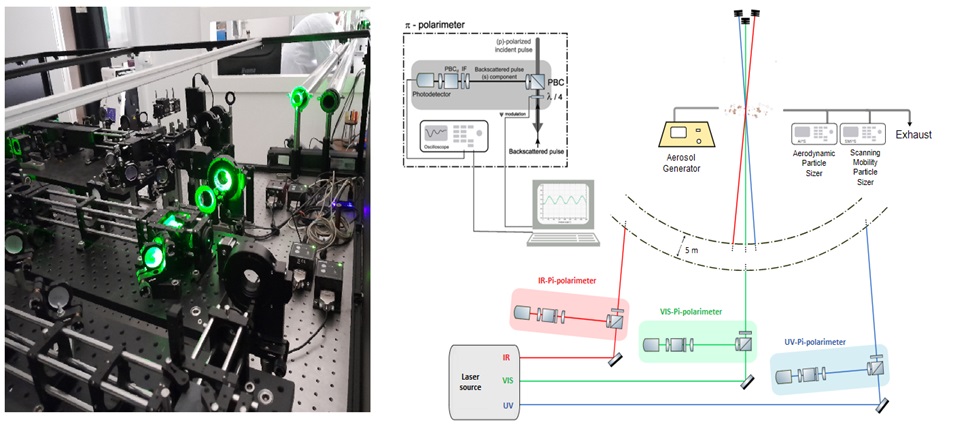condensed matter in the atmosphere : aerosols
Theme led by Alain Miffre
This research explores how light interacts with aerosol particles in the atmosphere for climate and public health purposes, as highlighted by the latest IPCC report (2021).
Aerosols, comprising diverse sizes, shapes, and refractive indices, pose challenges due to their complex nature. Innovative optical methods developed in the laboratory, alongside with field experiments based on lidar remote sensing, to bridge the gap between laboratory experiments and field experiments. Through this synergy, fundamental physics studies, aerosol metrology, and technology transfer are carried out. The most significant experimental achievement is the development of a laboratory instrument (Miffre et al., 2016), called LIAPS (Laboratory Instrument for Aerosol Polarimetry and Spectroscopy), assessing for the first time in laboratory the optical backscattering of a set of inhomogeneous particles of any shape suspended in the air (dilute medium).
Laboratory experiments : Mineral particles / Biogenic particles
Field experiments : lidar remote sensing

Picture and scheme of the LIAPS-experiment (Laboratory Instrument for Aerosol Polarimetry and Spectroscopy, world first)
Latest publications
Investigating the dependence of mineral dust depolarization on complex refractive index and size at 180.0° lidar backscattering angle, Atmos. Meas. Tech., 16, 403–417, (2023).
Light backscattering by atmospheric particles : from laboratory to field experiments, Book chapter, Springer Series in Light Scattering, Volume 8, Chapter 4, (2022).
Laboratory evaluation of the (355, 532) nm particles depolarization ratio of pure pollen at 180.0° lidar backscattering angle, Remote Sensing, 14, 3767, (2022).
Laboratory evaluation of the scattering matrix of ragweed, ash, birch and pine pollens towards pollen classification, Atmos. Meas. Tech., 15, 1021-1032, (2022).
Decrease in sulfate aerosol light backscattering due to reactive uptake of epoxydiols, Phys. Chem. Chem. Phys, 2021, 23, 5927-5935, (2021).
Latest communications
S. Bau, V. Crenn, S. Jacquinot, C. Debert, D. Petitprez, L. Leclerc, A. Miffre, A. Rose, A. Tomas, A. Kort, D. Hebert, A. Joubert, F. Deschamps, S. Ritoux, L. Ait Ali Yahia et F. Gaie-Levrel, Comparaison inter-laboratoires dédiée aux mesures de distributions granulométriques d’aérosols au moyen de compteurs optiques, Congrès Français des Aérosols, ASFERA, Paris, (2024).
Rôle de la taille et de l’indice optique de l’aérosol désertique dans son aptitude à rétrodiffuser la lumière : expérience de laboratoire à 180.0°, Congrès Français des Aérosols, ASFERA, Paris, (2024).
Laboratory evaluation of the lidar particle depolarization ratio of sulfates, soot, and mineral dust at 180.0° lidar backscattering angle, International Lidar Race Conference XXVII, Montana (US), (2022).
Matiere condensée de l' atmosphère : AéROSOLS
Thématique portée par Alain Miffre
Cette activité de recherche explore la manière dont la lumière interagit avec les particules d'aérosols de l'atmosphère avec des enjeux sur notre climat et sur la santé publique, comme le souligne le dernier rapport du GIEC (2021, The Physical Science Basis). Les aérosols, dont la taille, la forme et l'indice de réfraction varient, posent des problèmes en raison de leur nature complexe. Des méthodes optiques innovantes développées en laboratoire, ainsi que la télédétection par lidar, permettent de combler le fossé entre les expériences en laboratoire et les observations atmosphériques. Grâce à cette synergie, des études de physique fondamentale, de la métrologie des aérosols et du transfert de technologie sont réalisés. La réalisation expérimentale la plus importante est le développement d'un instrument de laboratoire (Miffre et al., 2016), appelé LIAPS (Laboratory Instrument for Aerosol Polarimetry and Spectroscopy), évaluant pour la première fois en laboratoire la rétrodiffusion optique d'un ensemble de particules inhomogènes de forme quelconque en suspension dans l'air (milieu dilué).
Expériences de laboratoire : Mineral particles / Biogenic particles
Expériences de terrain : lidar remote sensing

Photographie et schéma de principe de l'expérience LIAPS (Laboratory Instrument for Aerosol Polarimetry and Spectroscopy, première mondiale).
Dernières publications
Investigating the dependence of mineral dust depolarization on complex refractive index and size at 180.0° lidar backscattering angle, Atmos. Meas. Tech., 16, 403–417, (2023).
Light backscattering by atmospheric particles : from laboratory to field experiments, Book chapter, Springer Series in Light Scattering, Volume 8, Chapter 4, (2022).
Laboratory evaluation of the (355, 532) nm particles depolarization ratio of pure pollen at 180.0° lidar backscattering angle, Remote Sensing, 14, 3767, (2022).
Laboratory evaluation of the scattering matrix of ragweed, ash, birch and pine pollens towards pollen classification, Atmos. Meas. Tech., 15, 1021-1032, (2022).
Decrease in sulfate aerosol light backscattering due to reactive uptake of epoxydiols, Phys. Chem. Chem. Phys, 2021, 23, 5927-5935, (2021).
Dernières communications
S. Bau, V. Crenn, S. Jacquinot, C. Debert, D. Petitprez, L. Leclerc, A. Miffre, A. Rose, A. Tomas, A. Kort, D. Hebert, A. Joubert, F. Deschamps, S. Ritoux, L. Ait Ali Yahia et F. Gaie-Levrel, Comparaison inter-laboratoires dédiée aux mesures de distributions granulométriques d’aérosols au moyen de compteurs optiques, Congrès Français des Aérosols, ASFERA, Paris, (2024).
Rôle de la taille et de l’indice optique de l’aérosol désertique dans son aptitude à rétrodiffuser la lumière : expérience de laboratoire à 180.0°, Congrès Français des Aérosols, ASFERA, Paris, (2024).
Laboratory evaluation of the lidar particle depolarization ratio of sulfates, soot, and mineral dust at 180.0° lidar backscattering angle, International Lidar Race Conference XXVII, Montana (US), (2022).

















